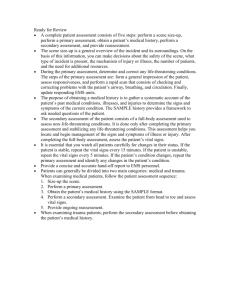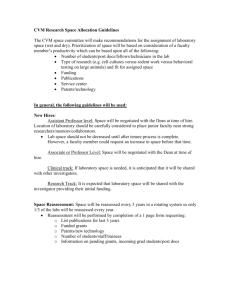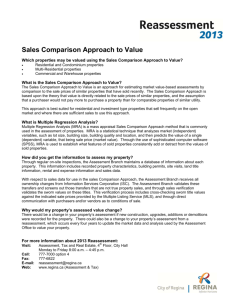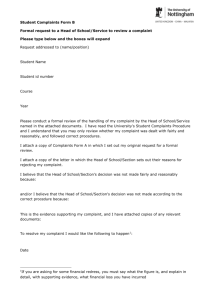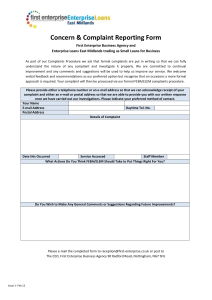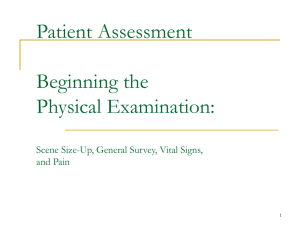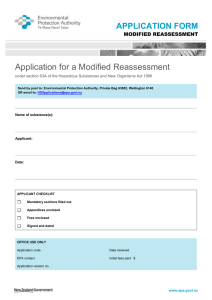Chapter 13: Patient Assessment
advertisement
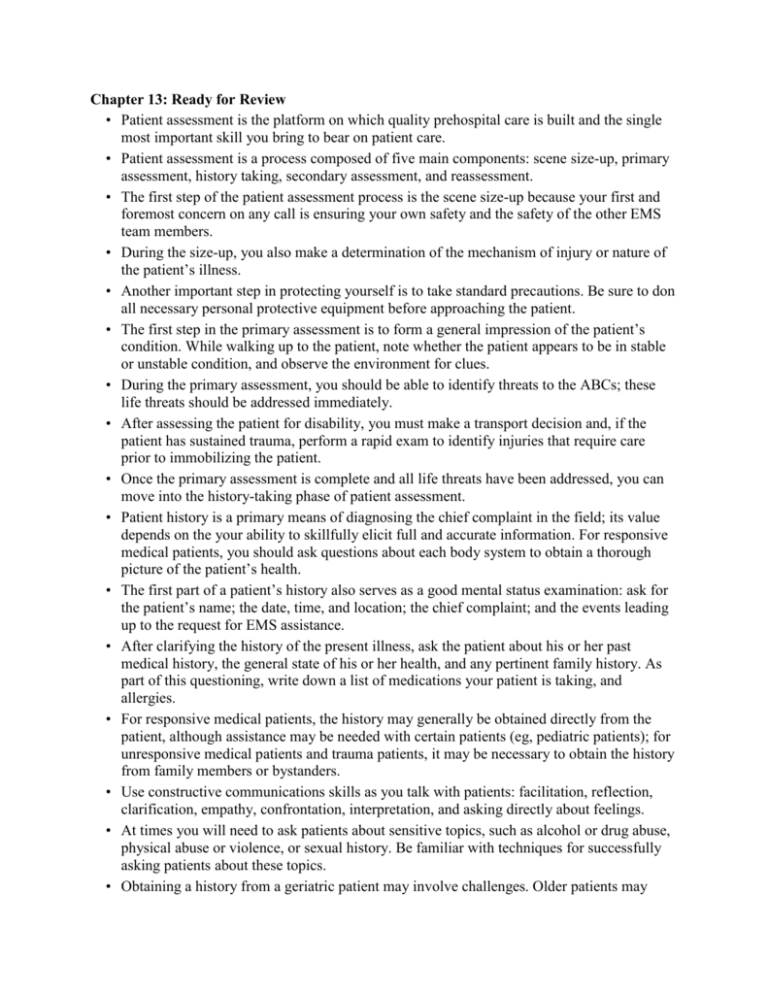
Chapter 13: Ready for Review • Patient assessment is the platform on which quality prehospital care is built and the single most important skill you bring to bear on patient care. • Patient assessment is a process composed of five main components: scene size-up, primary assessment, history taking, secondary assessment, and reassessment. • The first step of the patient assessment process is the scene size-up because your first and foremost concern on any call is ensuring your own safety and the safety of the other EMS team members. • During the size-up, you also make a determination of the mechanism of injury or nature of the patient’s illness. • Another important step in protecting yourself is to take standard precautions. Be sure to don all necessary personal protective equipment before approaching the patient. • The first step in the primary assessment is to form a general impression of the patient’s condition. While walking up to the patient, note whether the patient appears to be in stable or unstable condition, and observe the environment for clues. • During the primary assessment, you should be able to identify threats to the ABCs; these life threats should be addressed immediately. • After assessing the patient for disability, you must make a transport decision and, if the patient has sustained trauma, perform a rapid exam to identify injuries that require care prior to immobilizing the patient. • Once the primary assessment is complete and all life threats have been addressed, you can move into the history-taking phase of patient assessment. • Patient history is a primary means of diagnosing the chief complaint in the field; its value depends on the your ability to skillfully elicit full and accurate information. For responsive medical patients, you should ask questions about each body system to obtain a thorough picture of the patient’s health. • The first part of a patient’s history also serves as a good mental status examination: ask for the patient’s name; the date, time, and location; the chief complaint; and the events leading up to the request for EMS assistance. • After clarifying the history of the present illness, ask the patient about his or her past medical history, the general state of his or her health, and any pertinent family history. As part of this questioning, write down a list of medications your patient is taking, and allergies. • For responsive medical patients, the history may generally be obtained directly from the patient, although assistance may be needed with certain patients (eg, pediatric patients); for unresponsive medical patients and trauma patients, it may be necessary to obtain the history from family members or bystanders. • Use constructive communications skills as you talk with patients: facilitation, reflection, clarification, empathy, confrontation, interpretation, and asking directly about feelings. • At times you will need to ask patients about sensitive topics, such as alcohol or drug abuse, physical abuse or violence, or sexual history. Be familiar with techniques for successfully asking patients about these topics. • Obtaining a history from a geriatric patient may involve challenges. Older patients may • • • • • • • • • • • have multiple medical problems, may be taking numerous medications, and may present differently than adults, making their emergencies potentially more complex. They may have sensory losses that may require that you adjust your approach in order to gain the needed information. Work on strategies within your service and with your partner for positive communications with patients who are silent, overly talkative, seductive, having multiple symptoms, anxious, needing reassurance, angry or hostile, intoxicated, crying, or depressed. Secondary assessment (also known as the head-to-toe physical examination) is the process by which quantifiable, objective information is obtained from a patient about his or her overall state of health. There are times when you may not have time to perform a secondary assessment at all if the patient has serious life threats. Or, you may focus on the area of the chief complaint first, then move on to assessing all other body systems if time permits. The two types of physical examinations are the full-body exam and the focused assessment. The secondary assessment includes obtaining vital signs that measure overall body function, and performing a head-to-toe survey that evaluates the workings of specific body organ systems. This survey is done in a sequential manner, ensuring that every aspect of the body’s function is evaluated. The techniques of inspection, palpation, percussion, and auscultation allow you to use your physical senses to obtain physical information and to understand the normal (versus abnormal) functions of a patient’s body. Vital signs consist of a measurement of blood pressure; pulse rate, rhythm, and quality; respiratory rate, rhythm, and quality; temperature; and, if indicated, pulse oximetry. Other than overall patient appearance, vital signs are some of the most valuable objective data for determining patient status. Monitoring devices used by the paramedic include continuous ECG monitoring, 12-lead ECG, carbon dioxide monitoring (capnography and capnometry), blood chemistry analyses, and cardiac biomarkers, among others. You need to alter your approach to patient assessment when dealing with infants and children. Because a young child might not be able to speak, your assessment of his or her condition must be based in large part on what you can see and hear yourself. Family members or caregivers may also be able to provide useful information. After the primary assessment, the reassessment is the single most important assessment process you will perform. The reassessment is performed on all patients. It gives you an opportunity to reevaluate the chief complaint and to reassess interventions to ensure that they are still effective. Information from the reassessment may be used to identify and treat changes in the patient’s condition. A patient in stable condition should be reassessed every 15 minutes, whereas a patient in unstable condition should be reassessed every 5 minutes. A critical patient needs to be evaluated continuously.
